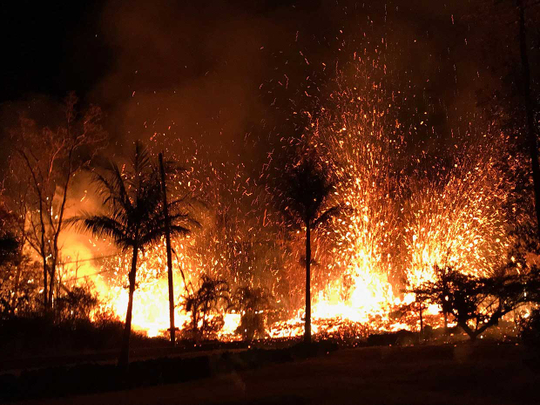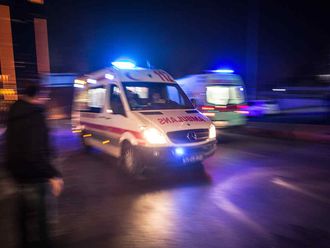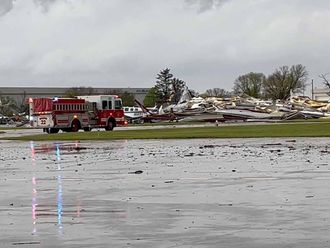
HILO, Hawaii: The flow of lava intensified Sunday from ongoing eruptions at Hawaii Island's Kilauea volcano, and molten rock is pouring from fissures that opened overnight, farther from the original eruptions.
Twenty-six homes and four unspecified structures have now been destroyed, The Associated Press reported, as residential destruction rapidly accelerated Sunday.
Toxic sulfur dioxide gas spewing near the fissures is at lethal concentrations, said US Geological Survey volcano scientist Wendy Stovall. Lava fountains emerging from the cracks in the ground are producing even more gas than previously observed.
The USGS Hawaiian Volcano Observatory said Sunday afternoon that since the overnight hours, eruptions of lava from cracks in the ground have been continuous.
A flow of lava has advanced northward for about 0.6 miles.
Residents have been evacuated from two remote, rural neighborhoods on the eastern edge of Hawaii Island where the lava is emerging from the fissures.
An estimated 1,800 people live in the affected area, and many have sought housing in shelters, with friends or on surrounding islands.
"Scientists on the ground are reporting that lava flows are traveling through the forest, power lines are coming down, and a few explosions have been heard — likely from propane tanks or methane explosions," Stovall said.
As lava inundates the heavily forested area, organic matter burns and releases methane.
Methane gas
"That methane gas can get trapped in pockets beneath lava flows or underground, and explode out violently, throwing rocks and debris in every direction," Stovall said.
Eruptions of lava fountains continued throughout the night. Because lava by Sunday morning was flowing farther than it did in the first days of the eruption, "that means the magma supply is still present and shows signs of continuing," Stovall said.
By Sunday morning on Hawaii, the overall number of total cracks that have at one point spewed or sputtered lava had risen to 10. On Saturday night, a new crack erupted between fissures No. 2 and No. 7, spewing lava fountains as high as 230 feet.
The flows are still moving quite slowly, however _ scientists from the U.S. Geological Survey monitoring them can walk away from the hot lava easily. On Sunday, a lava flow was moving away from Fissure No. 8 at significantly less than 1 mph, Stovall said.
A statement by the USGS volcano observatory said the lava flow northward from Fissure No. 8 began around 5 a.m. Sunday.
Images posted by the USGS showed red hot lava rising higher than the tops of trees. Other photos showed cracks in the ground and lava pouring over the asphalt of rural roads. On Friday, lava spatter was being launched over power lines.
It was the collapse of a lava-filled crater in the East Rift Zone on Monday that set off last week's eruption. The contents of the crater seeped into a network of underground channels and flowed downhill — and on Thursday started gushing out of cracks that had opened in Leilani Estates.
1,000 earthquakes
There have been more than 1,000 earthquakes over the last week in the area of Kilauea, produced by the volcano making room for new flows of magma occurring inside it.
Local government officials said if conditions permit, residents in Leilani Estates, the neighborhood where the eruptions have been occurring, would be allowed to enter the neighborhood to complete the evacuation of pets, medicine and key documents, but only during daylight hours.
Authorities warned that the air quality remained troublesome and that the roads were still under very unstable conditions, and residents could be required to leave the area if conditions became more hazardous. Another neighborhood, Lanipuna Gardens, remains under a mandatory evacuation order because of the high levels of toxic gases in the air.
The volcanic instability at Kilauea, one of the world's most active volcanoes and Hawaii Island's youngest, began on Monday underneath the eastern flank of the volcano, an area known as the East Rift Zone.
The largest so far was a magnitude 6.9 earthquake that hit midday Friday in the zone of volcanic activity. Although the earthquake could be felt across much of the archipelago, the worst shaking occurred in an area with no neighborhoods or businesses.
It is not unheard of for strong earthquakes — even those bigger than magnitude 6.9 — to follow volcanic activity. As molten rock moved underground from the collapsed lava-filled crater in the East Rift Zone to a lower elevation, the moving magma increased pressure in the entire area, Stovall said.
When that pressure built up, the surface around that had to move _ producing sudden earth movement on a fault plane that separates the ancient sea floor and Kilauea volcano.
Hawaii tourism officials emphasized that the volcano threat was limited to a remote region of eastern Hawaii Island and no flights to any airports in the state are being affected.
"The closest resort areas, in Kona and the Kohala Coast on the island of Hawaii's west side, are more than 100 miles away from where the lava flow is occurring and shielded by the massive mountains of Mauna Kea and Mauna Loa. Resort areas located on Oahu and Kauai, and in Maui County, are located hundreds of miles from Kilauea volcano," said a statement by the Hawaii Tourism Authority.












